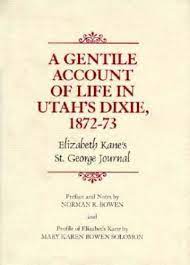Articles/Essays – Volume 30, No. 2
Revealing Insight | Norman R. Bowen, preface and notes, and Mary Karen Bowen Solomon, profile, A Gentile Account of Life in Utah’s Dixie, 1872-73: Elizabeth Kane’s St. George Journal
The publication of Elizabeth Kane’s journal for the months from December 1872 to March 1873 at St. George, Utah, was made possible by the Tanner Trust Fund of the University of Utah Marriott Library. (The Tanner Trust Fund is known for publishing exceptional materials on Utah, the Mormons and the West, culled from the library’s extensive holdings.)
Elizabeth Kane was a keen observer who recorded in some detail her observations of the people, problems of individuals and of the community, local customs and culture, general and specific material circumstances, Indian customs, characteristics, and relations with Mormons at St. George. But most significantly she recorded her observations and feelings regarding Mormon practices, doc trines, achievements, past sufferings, and the “unnatural conditions” of polygamy.
As wife of Colonel Thomas Kane, Mormon friend and benefactor, she found every door open to her and came to enjoy friendly associations with women and children of the community. Although she arrived with negative preconceptions of Mormons, through her experiences she came to conquer some of her prejudices. She found that Mormons were easily persuaded to tell stories of their persecutions, and as she intermingled, worshipped, and socialized, she came to pity a people so often driven from their homes and grew thankful for their prayers for her ill husband’s recovery.
Elizabeth’s outrage over polygamy even dimmed. She found in polygamous families a unity and a fondness for one another. She observed with some approval that women were required to be more in dependent as they often assumed management of families, households, and businesses while husbands were on missions, or, less agreeably, because polygamous men only visited wives instead of living with them day in and day out.
The women of St. George, as seen through Elizabeth Kane’s diary, were generally pleasant and intelligent. A few even dressed in modern fashions and spoke cultivated English. They expressed themselves clearly and sometimes eloquently regarding their faith, but continual toil and hardship kept them from scholarship. While some homes contained luxuries, most showed signs of poverty, but everything was spotlessly clean and the people bright and cheerful. Eventually, Mrs. Kane judged the people of St. George to be “the very best in the territory” (44).
She was impressed by the “perfect sincerity” (70) of all speakers at Sunday meetings and was convinced they believed what they said. There was nothing irreverent even as they took up temporal concerns in worship meetings. In fact, she found much to sympathize with in their religious life and their resignation to the Divine Will.
Brigham Young proved to be shrewd and so full of common sense that Mrs. Kane sometimes forgot he was a Mormon. His wonderful voice thrilled her even when he sometimes spoke for over an hour. After hearing him introduce the concept of the United Order of Enoch in February 1873, and observing the reactions of the Mormon people, she wondered if they abrogated the right to their own opinions. With his great persuasive power she wondered, “what might he be but for this slough of polygamy in which he is entangled”? (117)
Although she never could understand how a first wife brought herself to give her husband a new wife, she never asked any Mormon how a woman received only a part of her husband’s love. Although plural families seemed well governed, and some plural marriages, even after twenty years, seemed loving, she remained most repulsed by the sight of an old man married to a wife of his grand children’s age.
Even though Mormons erred from what she thought was the truth, she enjoyed her associations in St. George and allowed the stake patriarch to give her a patriarchal blessing (usually reserved for worthy Mor mons) which she recognized as somewhat prophetical but which would never make her a Mormon.
Elizabeth Kane found it hard to say farewell to St. George and did penance for her earlier hard thoughts and opinions. She vowed not to betray her honored and trusted Mormon friends because they had suffered enough from prying eyes and curious strangers, and she reared they would suffer still more in the future.
The Kane journal offers revealing insight into Mormonism of the 1870s. It is a quick and interesting read made more useful by helpful notes. There are, however, two minor errors observed in the notes. The first is an ap parent misprint which has William Hickman dying in 1833 (139), when he actually died in August 1883. The second identifies Augustus P. Hardy as a founding father of Harmony, Utah (91). This is a stretch since Harmony, the first settlement in Washington County, was founded in 1852. Hardy arrived in 1854 and spent just over two months there before going to preach to Native Americans near the Virgin River. Nevertheless, those interested in gentile impressions of Mormons, in southern Utah history, or in early Mormon village life will find this work illuminating and valuable.
A Gentile Account of Life in Utah’s Dixie, 1872-73: Elizabeth Kane’s St. George Journal. Preface and notes by Norman R. Bowen; profile by Mary Karen Bo wen Solomon (Salt Lake City: Tanner Trust Fund, 1995).


 Back to full Issue
Back to full Issue

